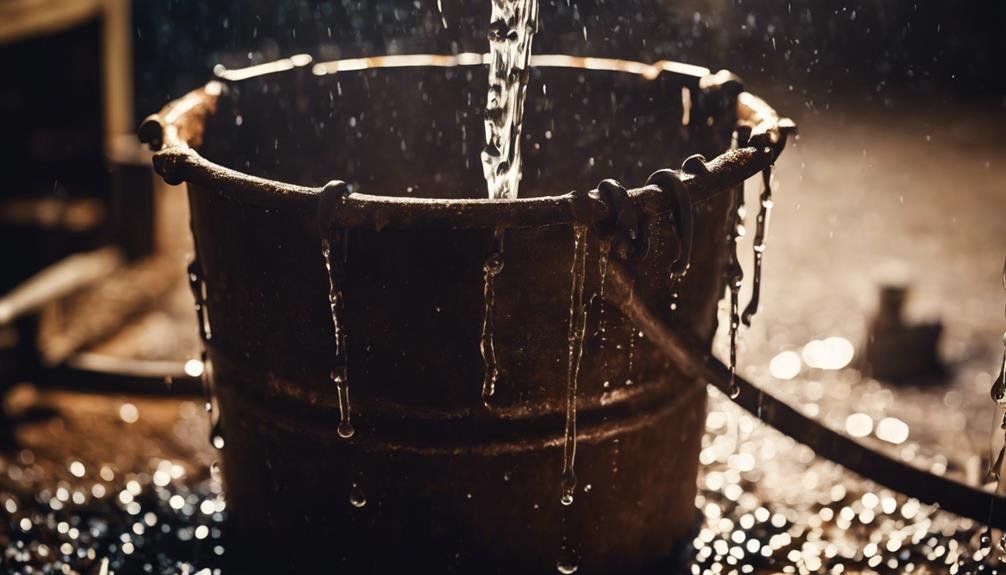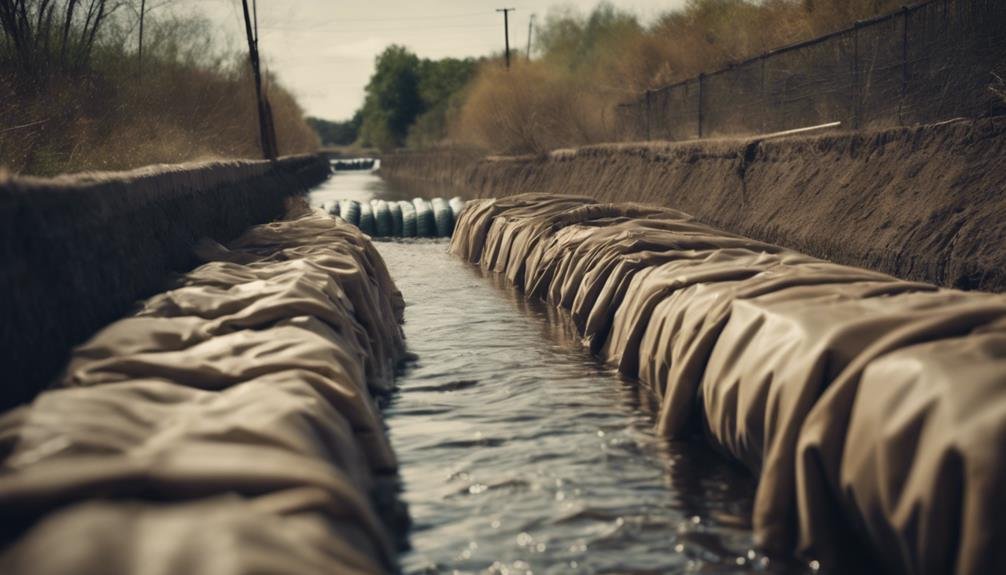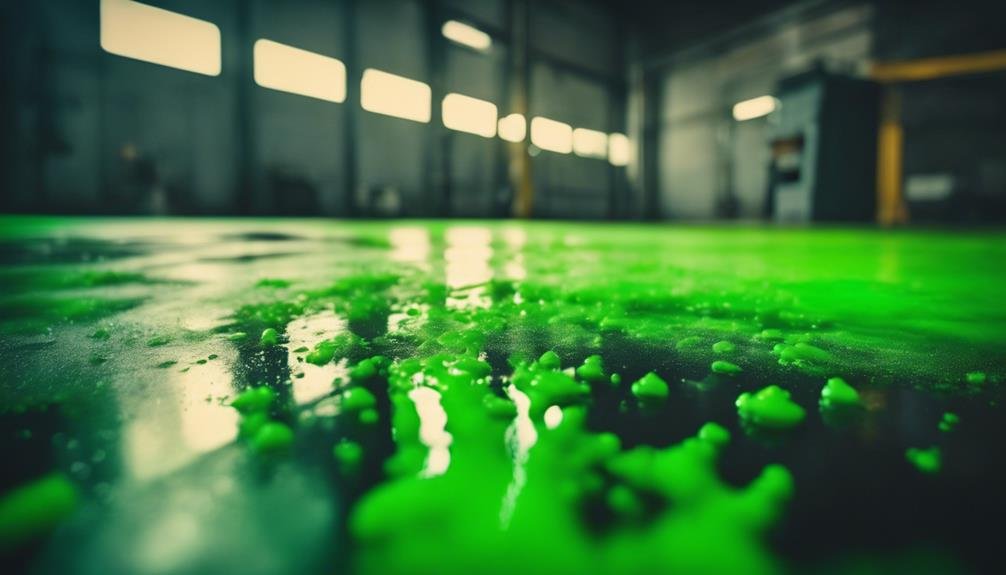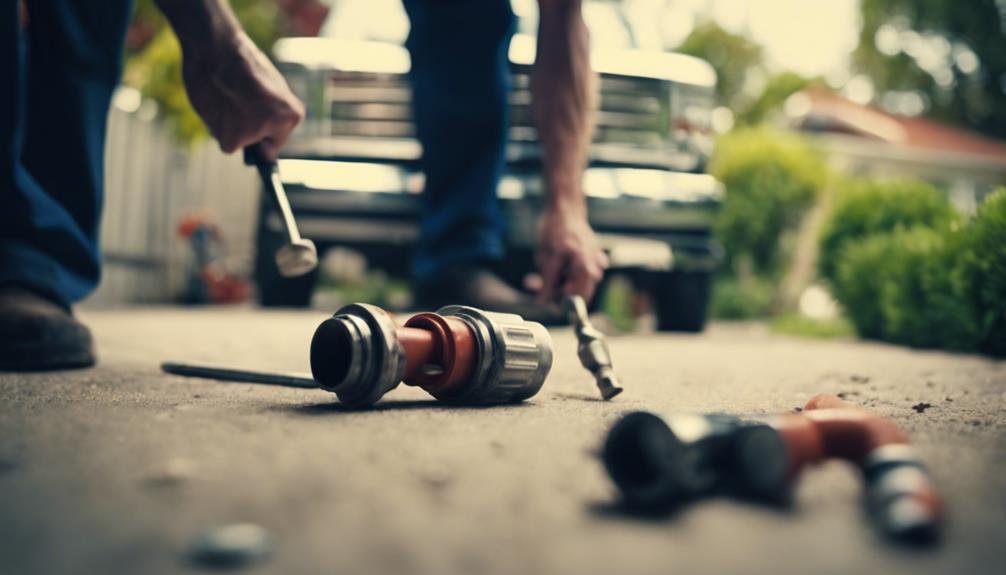We will act quickly to temporarily control leaks while working on long-term solutions. Quick-fix sealants like putty or tape can be used to seal cracks as a temporary measure.
Plastic sheeting can help protect against water damage, while using buckets to catch leaks can prevent further issues. Redirecting pipes and using dams to divert water can also help during repair work.
Monitoring systems are in place to detect any new leaks early on. If needed, we will shut off main water supplies to isolate affected areas. Professionals will assess risks, recommend containment strategies, and use specialized tools such as moisture sensors or infrared cameras to detect leaks.
Proper management of leaks is crucial in minimizing damage. If you are interested in exploring additional solutions or have any questions, please feel free to reach out.
Temporary Sealants
When dealing with leaks, a quick solution is to use temporary sealants. These sealants are designed to fill cracks or gaps temporarily, stopping the flow of liquids or gases until a permanent fix is in place.
Temporary sealants come in different forms like putty, sprays, or adhesive tapes. They're easy to apply on various surfaces like pipes, walls, roofs, and concrete. Choosing the right sealant for the specific material and type of leak is crucial for effectiveness.
While temporary sealants offer a convenient short-term fix, it's important to note that they aren't a lasting solution. They can degrade, crack, or lose their stickiness over time, leading to leaks resurfacing. It's essential to view them as a temporary measure and plan for a more permanent repair or replacement promptly.
Plastic Sheeting
When addressing leaks, it's essential to consider using plastic sheeting as a temporary solution. This method is crucial for safeguarding your property and belongings from water damage.
Selecting durable sheeting that can endure pressure is vital to ensure its effectiveness. Properly applying and removing the sheeting is key to maximizing its protective capabilities during emergencies.
Thickness and Tear Resistance
When selecting plastic sheeting for temporary leak control, it's crucial to choose a material with the right thickness and tear resistance. The sheeting should be thick enough to withstand water pressure and punctures while still being flexible for easy installation.
For residential use, a thickness of 6-10 mils is suitable, while commercial or industrial settings may require 10-20 mil sheeting.
Tear resistance is equally important to prevent rips or holes that could make the sheeting ineffective. Look for reinforced or woven plastic sheets that offer superior tear strength, able to withstand stress from wind, debris, or accidental impacts during installation or use.
Consider the sheeting's chemical resistance for contact with harsh substances like solvents or acids, and UV resistance for outdoor applications to prevent degradation over time.
Application and Removal Tips
Selecting the right plastic sheeting is crucial for effective leak protection. To ensure the best results, it's important to apply and remove the sheeting correctly. Here are some essential tips to follow:
- Surface Preparation:
Before applying the plastic sheeting, make sure to clean and dry the area thoroughly. Any dirt or moisture on the surface can compromise the seal, so it's essential to start with a clean slate.
- Overlapping and Sealing:
When installing the sheets, be sure to overlap adjoining pieces by at least 12 inches. Seal the seams with compatible tape or adhesive to prevent water from seeping through the edges. This extra layer of protection is key in keeping leaks at bay.
- Securing the Edges:
Use furring strips, battens, or other fasteners to secure the sheeting tightly against the surface. Pay close attention to corners and edges, as these areas are prone to leaks. Creating a watertight seal will ensure maximum protection against leaks.
When it comes time to remove the plastic sheeting, take care to peel it off slowly and carefully to avoid tearing. Roll up the used sheets for proper disposal. If there's any adhesive residue left behind, use a solvent-based cleaner to remove it from the surface.
Proper application and removal techniques play a critical role in the effectiveness of plastic sheeting in controlling leaks in the short term.
Bucket Catchment

When planning a bucket catchment system, the first step is to calculate the necessary capacity based on the leakage rate and the frequency of emptying. It's crucial to ensure proper drainage to avoid overflow and potential water damage.
By having a well-designed catchment system in place, risks can be minimized while a more permanent solution is being developed. Remember to consider factors such as the size of the catchment area, the material of the buckets, and the placement of the system to optimize its efficiency.
Additionally, using high-quality buckets and durable materials can prolong the lifespan of the catchment system and improve its overall performance. Regular maintenance and monitoring are also essential to ensure the system functions effectively.
Capacity Calculation
Calculating the necessary bucket capacity is crucial for containing leaks effectively. To determine the required volume, consider factors such as the leak's flow rate (measured in gallons per minute or liters per second), the expected duration of the leak before repairs, and a safety margin for unexpected changes.
Start by multiplying the flow rate by the anticipated duration and then add a safety margin of around 25% to ensure sufficient capacity.
For instance, if a leak is estimated to release 2 gallons per minute for 4 hours before repairs, with a 25% safety margin, the total required capacity would be 600 gallons.
Accurate capacity calculations are essential to prevent spills and damage. By ensuring the bucket can hold the entire leak volume without overflowing, you can effectively contain the situation.
Remember to make precise measurements and conservative estimates for successful short-term leak containment.
Drainage Provisions
Once the required capacity has been calculated, it's crucial to consider drainage provisions for the bucket catchment. A well-designed drainage system is essential to prevent overflow and ensure efficient water management. To achieve this, we recommend integrating a drainage pipe or channel to divert excess water away from the catchment area.
The following table provides guidance on the recommended drainage pipe sizes and materials based on the catchment area:
| Catchment Area (sq. ft.) | Pipe Diameter (inches) | Recommended Material |
|---|---|---|
| < 500 | 4 | PVC |
| 500 – 1000 | 6 | PVC or Corrugated Metal |
| > 1000 | 8 | Corrugated Metal |
It's important to ensure a proper slope for effective drainage, typically a minimum of 1% grade. Additionally, we suggest installing a sediment trap or filter to prevent debris from obstructing the drainage system. Regular inspection and maintenance of the drainage provisions are vital to ensure long-term effectiveness and avoid potential leaks or overflows.
Pipe Rerouting
A practical short-term solution involves redirecting leaking pipes to avoid the affected areas temporarily. This helps us:
- Quickly reduce water damage and safety risks.
- Maintain access to water in unaffected areas.
- Allow time for planning and implementing permanent repairs.
The process of pipe rerouting entails installing new pipe sections to bypass the leaks, connecting them to the current system, and sealing off the damaged parts. We'll carefully evaluate the leak locations, accessibility, and potential impact on the surrounding environment.
It is crucial to ensure that the new pipe arrangement doesn't disrupt existing infrastructure or create additional hazards. Implementing safety precautions, such as isolating the work area and arranging alternative water sources if needed, is vital during the rerouting procedure.
While rerouting provides a temporary fix, addressing the root cause of the leaks through thorough repairs or replacements is essential to restore the system's integrity and prevent future problems.
Water Diversion

One effective short-term approach to consider is water diversion. This method involves using temporary dams, reusable water barriers, and redirecting drainage to control the flow of water during repair work.
Temporary Dams
When dealing with a leak, setting up temporary dams can be a practical solution. These structures help divert water away from the leak, giving us time to manage the situation effectively. Temporary dams are a quick fix that allows us to address the root cause of the issue without further damage.
Temporary dams offer several advantages. Firstly, they redirect water flow, preventing additional harm or pollution in the affected area. Secondly, by controlling where the water goes, we can create a safer space for repair teams to operate. Lastly, these dams can be swiftly deployed in emergencies, providing essential containment.
To create a temporary dam, we typically use materials like sandbags, plastic sheeting, or inflatable barriers. The design and placement of the dam depend on factors such as water speed, terrain, and leak size.
While temporary dams aren't a permanent solution, they serve as a crucial temporary measure to contain a leak's immediate effects until more permanent repairs can be made.
Reusable Water Barriers
Reusable water barriers are a versatile solution for redirecting water flow and creating safer working conditions around leaks. These barriers can be used to build temporary dams or channels, guiding water away from areas that require repair. Constructed from sturdy, water-resistant materials such as reinforced PVC or polyethylene, they're designed to withstand water pressure without leaking or collapsing.
The key benefit of these barriers is their reusability. After use, they can be drained and stored for future projects, making them both cost-effective and environmentally friendly when compared to single-use sandbags. Setting up these barriers is quick and straightforward, allowing for rapid water diversion during emergencies.
Available in various sizes and shapes, they can be customized to suit different leaks and terrains. By controlling the flow of water, work can be carried out safely and efficiently to address issues like burst pipes or compromised water mains.
Drainage Rerouting
When dealing with leak mitigation efforts, temporary drainage rerouting becomes a valuable tool in effectively diverting water flow. This strategic redirection helps prevent further damage and eases repair work.
Here are three key benefits of using this method:
- Preventing Water Damage: By redirecting drainage, we can steer water away from affected areas, reducing the risk of additional water intrusion and minimizing structural damage or mold growth.
- Enhancing Repair Access: With the water flow directed elsewhere, we can access the leak source more easily, leading to more efficient repair processes and less need for extensive demolition or disruption.
- Temporary Fix: Drainage rerouting acts as a quick solution to manage the immediate impact of a leak, buying us time to develop and implement a permanent solution.
Implementing drainage rerouting involves assessing site conditions, determining diversion paths, and using suitable materials and techniques to safely redirect water flow. It's crucial to consider downstream effects and take precautions to prevent flooding or erosion in diversion areas. Effective planning and execution are key to maximizing the effectiveness of this short-term strategy.
Absorption Materials
Spill containment products like socks, booms, and pads are crucial for quickly addressing leaks before a permanent solution can be put in place. These products are typically made of hydrophilic materials such as polypropylene, which easily absorb liquids. When a leak occurs, we use socks or booms to create a barrier around the spill, while pads are used to absorb any puddles or trails of leaked fluid.
Socks are long tubes filled with fibers that we place around the leak to contain it, while booms are heavier and more rigid, making them ideal for larger spills. Pads, on the other hand, are flat absorbents that we lay over the leaked fluids. Once these products are saturated, they must be disposed of properly based on the type of liquid and its level of hazard.
Although absorption materials provide a temporary solution, it's essential to promptly identify and fix the source of the leak. These products help prevent contaminants from spreading and minimize the environmental impact of the leak until a permanent solution can be implemented.
Leak Detection

Detecting leaks promptly is crucial for implementing effective containment measures. There are several methods we rely on to identify leaks quickly:
- Visual inspection involves regularly checking equipment and surrounding areas for any signs of leakage, such as discoloration, wet spots, or puddles.
- Monitoring systems play a key role by installing sensors and alarms that can detect changes in pressure, flow rates, or unexpected presence of liquids.
- Routine testing, like dye penetrant tests or pressure tests, are conducted periodically to pinpoint potential leak sites before they escalate.
By detecting leaks early, we can respond promptly, minimizing the leak's impact and associated risks.
It's essential to have a comprehensive leak detection program in place, incorporating visual inspections, monitoring systems, and routine testing. Our personnel are trained to identify potential leak indicators and take immediate action to ensure the safety of our operations and the environment.
Water Cutoff
When a water leak occurs, acting promptly to stop the flow is crucial in minimizing damage and simplifying containment efforts. The main water supply line must be shut off quickly to prevent further leakage into the affected area. This immediate action allows for a more effective assessment of the situation without the added complication of ongoing water flow.
Once the water supply is turned off, attention can be focused on containing the existing leak and beginning the drying process. Locating the shutoff valve, usually situated near the water meter or main entry point, is essential as it stops the flow of water to the entire building or residence.
If the leak is coming from a specific fixture or appliance, isolating the water supply to that particular component can be a targeted solution that minimizes disruption to other areas. Understanding the plumbing system and identifying the appropriate shutoff valves can greatly simplify the process of containing leaks and preventing further damage.
Professional Assistance

When facing complex water leaks, it's crucial to rely on skilled professionals for assistance. Their expertise, specialized equipment, and commitment to safety make them invaluable in managing major leak issues effectively.
Professional help is essential for several reasons. Firstly, professionals are trained to identify the source of leaks, assess damage accurately, and apply the right repair methods efficiently. This ensures that the problem is resolved correctly the first time.
Secondly, professionals have access to specialized tools that are essential for locating and fixing leaks in challenging areas. These tools enable them to work behind walls and floors, where leaks are often hidden from view.
Lastly, safety is a top priority when dealing with major leaks. Professionals follow strict safety protocols and have insurance coverage to protect against potential risks, especially when dealing with electrical or structural components.
While there may be a cost associated with hiring professionals, their expertise, resources, and adherence to industry standards make them the most reliable solution for addressing significant water leaks.
Monitoring Strategy
Maintaining a vigilant monitoring approach is crucial for promptly identifying and addressing potential leaks before they become major problems. It's important to proactively inspect vulnerable areas and utilize various monitoring methods to detect leaks early on.
One effective technique is visual inspection, which involves physically examining areas prone to leaks for signs such as discoloration, dampness, or pooling water.
In addition to visual checks, advanced leak detection tools like moisture sensors, acoustic monitoring devices, and infrared cameras can be used to detect even the smallest leaks that may be hidden from view.
Moisture sensors are designed to detect changes in moisture levels, providing alerts when thresholds are exceeded. Acoustic monitoring devices can identify water flow sounds, helping pinpoint the exact location of a leak. These tools offer continuous real-time monitoring and are ideal for hard-to-access areas where leaks may go unnoticed for longer periods.
Conclusion
To prevent damage from leaks, we can implement temporary solutions like caulking cracks and rerouting pipes. Regular monitoring is essential to catch any new leaks early on.
Acting promptly to fix leaks helps reduce water wastage and property damage, ensuring that our homes and businesses stay dry and secure.
Remember, quick action now can save us from bigger problems later on.

